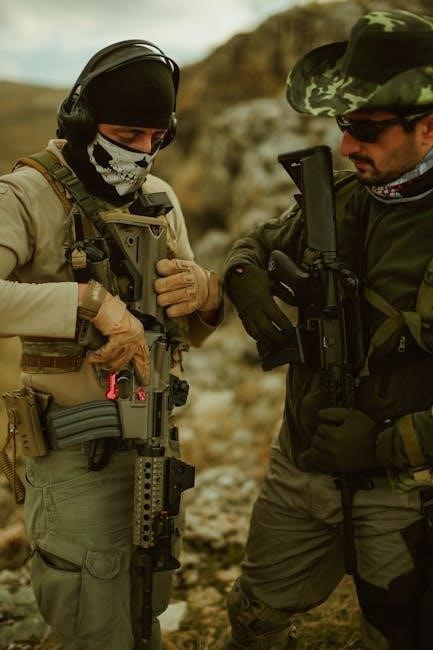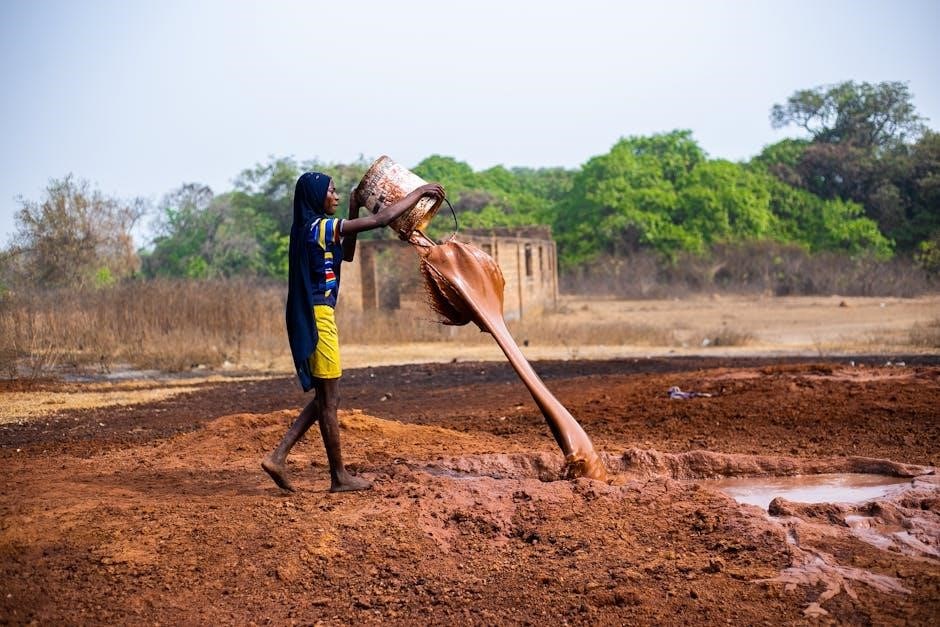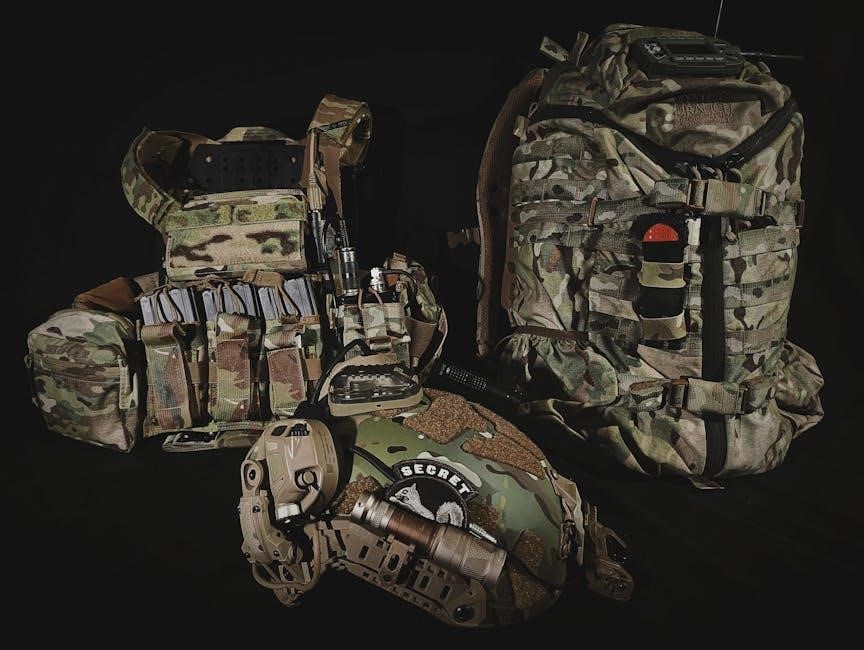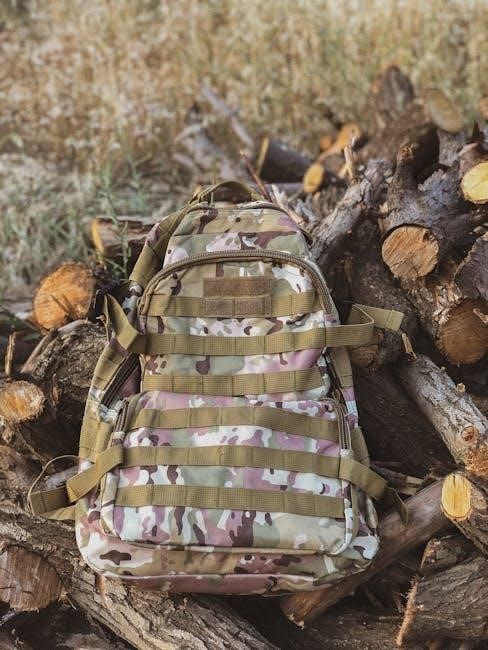
us army survival field manual
The U․S․ Army Survival Field Manual (FM 21-76) is a comprehensive guide designed to equip soldiers and civilians with essential survival skills in various environments․
Overview of the FM 21-76 Manual
The FM 21-76 manual, published by the U․S․ Army, serves as a detailed survival guide for soldiers and civilians alike․ Initially released in 1969 and updated in 1999 as FM 3-05․70, it provides practical techniques for survival in diverse environments․ The manual emphasizes the SURVIVAL acronym, offering a structured approach to staying alive in hostile conditions․ It covers topics such as finding food, building shelter, and navigating terrain․ Widely used for military training, the guide is also valued by outdoor enthusiasts for its comprehensive and field-tested strategies․
Importance of Survival Skills in the Military
Survival skills are critical for military personnel, enabling them to endure and operate in hostile environments․ These skills ensure mission completion, safeguard lives, and maintain unit effectiveness․ The ability to adapt to extreme conditions, such as deserts, jungles, or cold climates, is vital for survival․ Soldiers trained in survival techniques can recover from isolation, evade capture, and resist exploitation․ These skills also foster mental resilience, boosting confidence and the will to survive․ The U․S․ Army Survival Manual emphasizes these principles, ensuring soldiers are prepared to overcome life-threatening challenges in any theater of operation․

The SURVIVAL Acronym
The SURVIVAL acronym serves as a foundational guide, with each letter representing a key principle to follow in life-threatening situations, ensuring effective decision-making and action․
Understanding the Key Components of the SURVIVAL Mnemonic

The SURVIVAL acronym is a memorable tool that outlines critical steps for staying alive in hostile environments․ Each letter represents a key action or mindset: Size up your situation, Use all senses, Remember survival priorities, Vanquish fear and panic, Iimprovise and adapt, Value living, and Act like a survivor․ By breaking down each component, individuals can systematically approach survival challenges, ensuring clarity and focus during high-stress situations․
Applying the SURVIVAL Acronym in Real-World Scenarios
The SURVIVAL acronym provides a practical framework for decision-making in life-threatening situations․ For instance, sizing up the environment helps identify immediate dangers, while using all senses enhances situational awareness․ Remembering survival priorities ensures focus on shelter, water, and food․ Vanquishing fear and panic is crucial for maintaining clarity, and improvising with available resources fosters adaptability; Valuing life and acting like a survivor reinforces determination, leading to effective execution of survival strategies in diverse scenarios, such as desert, jungle, or urban environments․ This systematic approach increases chances of rescue and survival․

Survival in Different Environments
The U․S․ Army Survival Field Manual provides tailored strategies for surviving in diverse environments, including deserts, jungles, and cold climates, emphasizing adaptation to extreme conditions and resourcefulness․
Desert Survival Techniques
Desert survival requires mastering water conservation, as dehydration is the primary threat․ The manual emphasizes finding water in cacti, underground, or through condensation․ Rationing food and water is critical, as resources are scarce․ Building shaded shelters using natural materials like sand and rocks helps protect from extreme heat․ Signaling for rescue is vital, using smoke, mirrors, or reflective objects․ Staying visible and avoiding sandstorms are key․ The manual also stresses the importance of mental resilience and resourcefulness to endure the harsh desert environment effectively․
Jungle Survival Strategies
Jungle survival requires adapting to dense vegetation and high humidity․ The manual highlights finding water in streams or through transpiration, using plants like bamboo․ Food sources include fruits, insects, and small animals․ Building shelters with natural materials like leaves and vines is essential․ Navigation using the sun’s position and natural landmarks is crucial․ Signaling for help with smoke or reflective objects increases visibility․ Avoiding hazards like venomous wildlife and staying mentally resilient are key to enduring the challenging jungle environment effectively․
Cold Weather Survival Methods
Cold weather survival requires prioritizing warmth, hydration, and shelter․ The manual emphasizes finding or creating water sources by melting snow and avoiding dehydration․ Layering clothing and using natural materials like snow blocks or pine branches for insulation is crucial․ Building shelters such as igloos or snow trenches provides protection from wind and cold․ Starting fires with dry wood and maintaining them is vital for warmth and signaling․ Staying visible with reflective gear and avoiding overexertion helps prevent hypothermia and frostbite, ensuring survival in freezing environments․

Basic Survival Skills
Basic survival skills include finding food, building shelter, and signaling for help, essential for staying safe, protecting from elements, and maintaining a positive mental attitude in challenging environments․
Finding Food and Water in the Wild
Locating a reliable water source is critical for survival․ Purify water using methods like boiling, solar disinfection, or sand filtration to avoid contamination․ Identify edible plants by their characteristics, avoiding poisonous species․ Hunting and trapping small animals can provide protein, while fishing requires knowledge of aquatic life․ Always prioritize water safety and food identification to prevent illness․ Efficient foraging and water collection techniques ensure sustainability in wilderness environments, keeping you nourished and hydrated during prolonged survival situations․
Signaling for Help and Rescue
Effective signaling is crucial for rescue․ Use fire, smoke, or mirrors to signal during the day, and fires or flares at night․ Create large, visible ground signs using rocks or branches․ Whistles are excellent for auditory signals—three short blasts indicate distress․ Ensure signals are clear and consistent to maximize visibility to rescuers․ Knowledge of these techniques increases the likelihood of being noticed and rescued promptly in survival situations․
Building Shelter and Protecting Yourself from the Elements
Building shelter is a priority in survival situations to protect against wind, rain, snow, and extreme temperatures․ Use natural materials like branches, leaves, and snow to construct lean-tos, debris huts, or snow shelters․ Ensure the structure is sturdy and waterproof․ In forested areas, create a bed of pine needles or grasses for insulation․ Utilize ponchos, tarps, or plastic bags to enhance water resistance․ Proper shelter helps conserve energy, maintain body heat, and prevent exposure-related illnesses, increasing chances of survival in harsh environments․

Navigation and Orientation
Navigation and orientation are critical survival skills, focusing on identifying natural landmarks, using celestial navigation, and employing compass and map techniques to maintain direction and locate resources effectively․
Using Natural Landmarks for Navigation
Using natural landmarks is a fundamental navigation technique emphasized in the U․S․ Army Survival Manual․ By identifying distinctive features like ridges, valleys, and water sources, individuals can maintain orientation․ The position of the sun, moon, and stars can also help determine direction․ Understanding how to read natural signs, such as the growth patterns of vegetation and the flow of streams, enhances navigation accuracy․ These methods are especially crucial in environments without modern tools, ensuring effective movement and resource location․
Understanding Compass and Map Reading
The U․S․ Army Survival Manual emphasizes mastering compass and map reading as vital navigation skills․ A compass provides direction, while maps offer terrain details․ To navigate effectively, align the compass with the map’s orientation, ensuring the needle points north․ Use contour lines and symbols to identify features like elevations, water sources, and roads․ Practice measuring distances and plotting routes to enhance accuracy․ These skills are essential for determining location and movement, especially in unfamiliar or hostile environments, ensuring safe and efficient travel․

Mental and Physical Health
Maintaining mental toughness and physical stamina is crucial for survival․ A positive mindset helps overcome challenges, while physical health ensures endurance in demanding situations․ Stay focused and resilient․
Maintaining a Positive Mental Attitude
Mental resilience is a cornerstone of survival․ A positive attitude helps overcome fear, panic, and despair, enabling clear thinking and decisive action․ Avoid negative thoughts, as they can undermine resolve and cloud judgment․
- Stay focused on survival goals and break tasks into manageable steps․
- Draw strength from training, experience, and the belief in your ability to adapt․
- Remember, survival is 80% mental and 20% physical—cultivate confidence and determination․
A positive mindset not only enhances survival chances but also fosters hope, a critical factor in enduring extreme conditions․
Physical Health and Endurance in Survival Situations
Physical health and endurance are critical for survival․ Maintaining energy levels, preventing exhaustion, and staying hydrated are essential․ Soldiers must balance activity with rest to avoid overexertion, while proper nutrition and sleep sustain physical stamina․ In extreme conditions, managing body temperature is vital to prevent heatstroke or hypothermia․ A healthy body enhances resilience, allowing individuals to endure prolonged survival scenarios and perform tasks effectively․ Prioritizing physical well-being ensures greater chances of survival and success in hostile environments․
- Conserve energy by pacing activities․
- Stay hydrated to maintain physical functions․
- Avoid extreme temperatures to prevent health risks․

Protection and Self-Defense
Protection and self-defense are vital in survival situations․ Soldiers must safeguard against wildlife and hostile forces, utilizing improvised weapons and field-tested techniques to ensure safety and deter threats․
- Use surroundings to create defensive barriers․
- Employ makeshift weapons for self-defense․
- Stay mentally prepared to react swiftly․
Protecting Yourself from Wildlife and Hostile Forces
Protecting yourself from wildlife and hostile forces is critical in survival situations․ The U․S․ Army Survival Field Manual emphasizes the use of improvised weapons and natural barriers to deter threats․ Stay alert and avoid confrontations when possible․ Use your environment to create defensive positions, such as rocks or logs, to shield yourself․ Mental preparedness is equally important—stay calm and decisive to respond effectively․ Always prioritize evasive maneuvers over direct engagement unless absolutely necessary for self-defense․
Using Improvised Weapons for Self-Defense
Improvising weapons is a critical survival skill emphasized in the U․S․ Army Survival Field Manual․ Use readily available materials like sticks, rocks, or metal scraps to craft effective tools․ A spear can be made by sharpening a branch, while a sling can hurl projectiles with precision․ Even everyday items like belts or clothing can be repurposed for defense․ The manual stresses the importance of creativity and mental preparedness in fabricating weapons to ensure safety in hostile environments․

First Aid and Wound Management
First aid and wound management are critical survival skills․ The manual outlines steps for cleaning wounds, applying dressings, and preventing infection to maintain health in challenging conditions․
Basic First Aid Techniques
The U․S․ Army Survival Manual emphasizes wound cleaning, dressing, and infection prevention․ It outlines steps for controlling bleeding, applying tourniquets, and splinting fractures․ The manual also covers recognizing signs of shock, treating burns, and managing exposure․ These techniques are essential for maintaining health in survival situations, ensuring wounds heal properly and preventing further complications․ The guide provides clear, actionable steps to stabilize injuries until professional medical help is available․
Managing Injuries and Preventing Infection
The U․S․ Army Survival Manual stresses the importance of proper wound care to prevent infection․ It advises cleaning injuries with sterile or purified water and applying antiseptic solutions․ The manual recommends monitoring wounds for signs of infection, such as redness, swelling, or pus, and taking immediate action if they appear․ Dressings should be changed regularly, and fractures or sprains must be immobilized using splints․ These techniques are critical for preventing infections and promoting healing in survival scenarios where medical assistance may be unavailable․